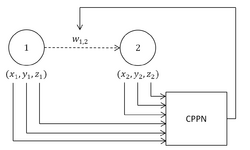HyperNEAT
From HandWiki
Hypercube-based NEAT, or HyperNEAT,[1] is a generative encoding that evolves artificial neural networks (ANNs) with the principles of the widely used NeuroEvolution of Augmented Topologies (NEAT) algorithm developed by Kenneth Stanley.[2] It is a novel technique for evolving large-scale neural networks using the geometric regularities of the task domain. It uses Compositional Pattern Producing Networks [3] (CPPNs), which are used to generate the images for Picbreeder.org and shapes for EndlessForms.com . HyperNEAT has recently been extended to also evolve plastic ANNs [4] and to evolve the location of every neuron in the network.[5]
Applications to date
- Multi-agent learning[6]
- Checkers board evaluation[7]
- Controlling Legged Robots[8][9][10][11][12][13]video
- Comparing Generative vs. Direct Encodings[14][15][16]
- Investigating the Evolution of Modular Neural Networks[17][18][19]
- Evolving Objects that can be 3D-printed[20]
- Evolving the Neural Geometry and Plasticity of an ANN[21]
References
- ↑ Stanley, Kenneth O.; D'Ambrosio, David B.; Gauci, Jason (2009-01-14). "A Hypercube-Based Encoding for Evolving Large-Scale Neural Networks". Artificial Life 15 (2): 185–212. doi:10.1162/artl.2009.15.2.15202. ISSN 1064-5462. PMID 19199382. https://stars.library.ucf.edu/facultybib2000/2178.
- ↑ Stanley, Kenneth O.; Miikkulainen, Risto (2002-06-01). "Evolving Neural Networks through Augmenting Topologies". Evolutionary Computation 10 (2): 99–127. doi:10.1162/106365602320169811. ISSN 1063-6560. PMID 12180173.
- ↑ Stanley, Kenneth O. (2007-05-10). "Compositional pattern producing networks: A novel abstraction of development" (in en). Genetic Programming and Evolvable Machines 8 (2): 131–162. doi:10.1007/s10710-007-9028-8. ISSN 1389-2576.
- ↑ Risi, Sebastian; Stanley, Kenneth O. (2010-08-25). "Indirectly Encoding Neural Plasticity as a Pattern of Local Rules". in Doncieux, Stéphane (in en). From Animals to Animats 11. Lecture Notes in Computer Science. 6226. Springer Berlin Heidelberg. pp. 533–543. doi:10.1007/978-3-642-15193-4_50. ISBN 9783642151927.
- ↑ Risi, Sebastian; Stanley, Kenneth O. (2012-08-31). "An Enhanced Hypercube-Based Encoding for Evolving the Placement, Density, and Connectivity of Neurons". Artificial Life 18 (4): 331–363. doi:10.1162/ARTL_a_00071. ISSN 1064-5462. PMID 22938563. https://stars.library.ucf.edu/facultybib2010/3197.
- ↑ D'Ambrosio, David B.; Stanley, Kenneth O. (2008-01-01). "Generative encoding for multiagent learning". Proceedings of the 10th annual conference on Genetic and evolutionary computation. GECCO '08. New York, NY, USA: ACM. pp. 819–826. doi:10.1145/1389095.1389256. ISBN 9781605581309.
- ↑ J. Gauci and K. O. Stanley, “A case study on the critical role of geometric regularity in machine learning,” in AAAI (D. Fox and C. P. Gomes, eds.), pp. 628–633, AAAI Press, 2008.
- ↑ Risi, Sebastian; Stanley, Kenneth O. (2013-01-01). "Confronting the challenge of learning a flexible neural controller for a diversity of morphologies". Proceedings of the 15th annual conference on Genetic and evolutionary computation. GECCO '13. New York, NY, USA: ACM. pp. 255–262. doi:10.1145/2463372.2463397. ISBN 9781450319638.
- ↑ Clune, J.; Beckmann, B. E.; Ofria, C.; Pennock, R. T. (2009-05-01). "Evolving coordinated quadruped gaits with the HyperNEAT generative encoding". 2009 IEEE Congress on Evolutionary Computation. pp. 2764–2771. doi:10.1109/CEC.2009.4983289. ISBN 978-1-4244-2958-5.
- ↑ Clune, Jeff; Ofria, Charles; Pennock, Robert T. (2009-01-01). "The sensitivity of HyperNEAT to different geometric representations of a problem". Proceedings of the 11th Annual conference on Genetic and evolutionary computation. GECCO '09. New York, NY, USA: ACM. pp. 675–682. doi:10.1145/1569901.1569995. ISBN 9781605583259.
- ↑ Yosinski J, Clune J, Hidalgo D, Nguyen S, Cristobal Zagal J, Lipson H (2011) Evolving Robot Gaits in Hardware: the HyperNEAT Generative Encoding Vs. Parameter Optimization. Proceedings of the European Conference on Artificial Life. (pdf)
- ↑ Lee S, Yosinski J, Glette K, Lipson H, Clune J (2013) Evolving gaits for physical robots with the HyperNEAT generative encoding: the benefits of simulation. Applications of Evolutionary Computing. Springer. pdf
- ↑ Lee, Suchan; Yosinski, Jason; Glette, Kyrre; Lipson, Hod; Clune, Jeff (2013-04-03). "Evolving Gaits for Physical Robots with the HyperNEAT Generative Encoding: The Benefits of Simulation". in Esparcia-Alcázar, Anna I. (in en). Applications of Evolutionary Computation. Lecture Notes in Computer Science. 7835. Springer Berlin Heidelberg. pp. 540–549. doi:10.1007/978-3-642-37192-9_54. ISBN 9783642371912.
- ↑ Clune, J.; Stanley, K. O.; Pennock, R. T.; Ofria, C. (2011-06-01). "On the Performance of Indirect Encoding Across the Continuum of Regularity". IEEE Transactions on Evolutionary Computation 15 (3): 346–367. doi:10.1109/TEVC.2010.2104157. ISSN 1089-778X.
- ↑ Clune, Jeff; Ofria, Charles; Pennock, Robert T. (2008-09-13). "How a Generative Encoding Fares as Problem-Regularity Decreases". in Rudolph, Günter (in en). Parallel Problem Solving from Nature – PPSN X. Lecture Notes in Computer Science. 5199. Springer Berlin Heidelberg. pp. 358–367. doi:10.1007/978-3-540-87700-4_36. ISBN 9783540876991.
- ↑ Clune, Jeff; Beckmann, Benjamin E.; Pennock, Robert T.; Ofria, Charles (2009-09-13). "HybrID: A Hybridization of Indirect and Direct Encodings for Evolutionary Computation". in Kampis, George (in en). Advances in Artificial Life. Darwin Meets von Neumann. Lecture Notes in Computer Science. 5778. Springer Berlin Heidelberg. pp. 134–141. doi:10.1007/978-3-642-21314-4_17. ISBN 9783642213137.
- ↑ Clune, Jeff; Beckmann, Benjamin E.; McKinley, Philip K.; Ofria, Charles (2010-01-01). "Investigating whether hyperNEAT produces modular neural networks". Proceedings of the 12th annual conference on Genetic and evolutionary computation. GECCO '10. New York, NY, USA: ACM. pp. 635–642. doi:10.1145/1830483.1830598. ISBN 9781450300728.
- ↑ Suchorzewski, Marcin; Clune, Jeff (2011-01-01). "A novel generative encoding for evolving modular, regular and scalable networks". Proceedings of the 13th annual conference on Genetic and evolutionary computation. GECCO '11. New York, NY, USA: ACM. pp. 1523–1530. doi:10.1145/2001576.2001781. ISBN 9781450305570.
- ↑ Verbancsics, Phillip; Stanley, Kenneth O. (2011-01-01). "Constraining connectivity to encourage modularity in HyperNEAT". Proceedings of the 13th annual conference on Genetic and evolutionary computation. GECCO '11. New York, NY, USA: ACM. pp. 1483–1490. doi:10.1145/2001576.2001776. ISBN 9781450305570.
- ↑ Clune, Jeff; Lipson, Hod (2011-11-01). "Evolving 3D Objects with a Generative Encoding Inspired by Developmental Biology". SIGEVOlution 5 (4): 2–12. doi:10.1145/2078245.2078246. ISSN 1931-8499.
- ↑ Risi, S.; Stanley, K. O. (2012-06-01). "A unified approach to evolving plasticity and neural geometry". The 2012 International Joint Conference on Neural Networks (IJCNN). pp. 1–8. doi:10.1109/IJCNN.2012.6252826. ISBN 978-1-4673-1490-9.
External links
- HyperNEAT Users Page
- Ken Stanley's website
- "Evolutionary Complexity Research Group at UCF"
- NEAT Project Homepage
- PicBreeder.org
- EndlessForms.com
- BEACON Blog: What is neuroevolution?
 |


